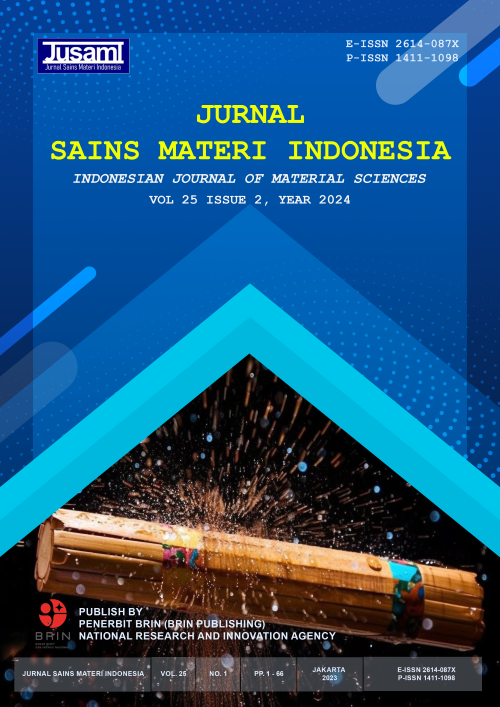Formulation and Characterization of Dewandaru Fruit Extract in Nanocarrier System
DOI:
https://doi.org/10.55981/jsmi.2024.3121Keywords:
Dewandaru, Homogenizer, Milling, Nanoemulsion, NanoencapsulationAbstract
Dewandaru (Eugenia uniflora L.) is a herbaceous plant that grows in tropical and subtropical regions. The fruit extract can prevent oxidative damage and cholinergic changes. It contributes to antihyperglycemic, antihyperlipidemic, and neuroprotective due to its antioxidants and antidepressant effect. It also possesses antibacterial and anti-inflammatory activity and potentially prevents cardiovascular disease and cancer. In this study, dewandaru fruit extract was formulated in the nanocarrier system (nanoemulsion and nanoencapsulation) to preserve product stability and improve product dispersibility and bioavailability. The nanoemulsion optimum formulation condition was obtained on dewandaru fruit extract concentration 10 wt%, oil/surfactant ratio 0.25, and homogenization speed 20.000 rpm, resulting in particle size of 46.4 ± 0.4 nm and polydispersity index 0.480 ± 0.015. The optimum nanoemulsion formulation was further processed to nanoencapsulation along with milling to produce finer particles. The nanoencapsulation milled for 120 minutes produced encapsulation powder with a size of 5.8 ± 3.340 μm. Accordingly, the nanocarrier technology for dewandaru fruit extract promoted a versatile medicinal preparation both in liquid and solid form. However, the size reduction by milling might disrupt the efficiency of the encapsulation release system. Without the proper coating, as orally administrated, the compound rapidly dissolved before it reached the targeted site.
Downloads
References
R. C. Franzon, S. Carpenedo, M. D. Viñoly, and M. do C. B. Raseira. “Pitanga—Eugenia uniflora L.” Exot. Fruits, pp. 333–338, 2018.
P. S. Oliveira. V. C. Chaves, N. P. Bona, M. S. P. Soares, J. de Souza Cardoso, F. A. Vasconcellos, R. G. Tavares, M. Vizzotto, L. M. C. da Silva, F. B. Grecco, G. D. Gamaro, R. M. Spanevello, C. L. Lencina, F. H. Reginatto, and F. M. Stefanello. “Eugenia uniflora fruit (red type) standardized extract: A potential pharmacological tool to diet-induced metabolic syndrome damage management.” Biomed. Pharmacother., vol. 92, pp. 935–941, 2017.
A. L. Oliveira, E. S. Kamimura, and J. A. Rabi. “Response surface analysis of extract yield and flavour intensity of Brazilian cherry (Eugenia uniflora L.) obtained by supercritical carbon dioxide extraction.” Innov. Food Sci. Emerg. Technol., vol. 10, no. 2, pp. 189–194, 2009.
C. C. Denardin, G. E. Hirsch, R. F. da Rocha, M. Vizzotto, A. T. Henriques, J. C. F. Moreira, F. T. C. R. Guma, and T. Emanuelli. “Antioxidant capacity and bioactive compounds of four Brazilian native fruits.” J. Food Drug Anal., vol. 23, no. 3, pp. 387–398, 2015.
I. Indrawati, F. A. L. Safitri, and N. Rossiana. “Bioprospecting of fruit extract and endophytic bacteria isolated from dewandaru (Eugenia uniflora L.) as antibacterial against colorectal bacteria.” IOP Conf. Ser. Earth Environ. Sci., vol. 457, p. 012048, 2020.
V. D. C. Jovito, I. A. Freires, D. A. de H. Ferreira, M. D. Q. Paulo, and R. D. De Castro. “Eugenia uniflora dentifrice for treating gingivitis in children: Antibacterial assay and randomized clinical trial.” Braz. Dent. J., vol. 27, no. 4, pp. 387–392, 2016.
I. Theochari, A. Xenakis, and V. Papadimitriou. “Chapter 19-Nanocarriers for effective drug delivery,” in Smart Nanocontainers. P. Nguyen-Tri, T. -O. Do, and T. A. Nguyen, Eds. Elsevier, 2020, pp. 315–341.
X. Xu, W. Ho, X. Zhang, N. Bertrand, and O. Farokhzad. “Cancer nanomedicine: From targeted delivery to combination therapy.” Trends Mol. Med., vol. 21, no. 4, pp. 223–232, 2015.
M. Chaari, I. Theochari, V. Papadimitriou, A. Xenakis, and E. Ammar. “Encapsulation of carotenoids extracted from halophilic Archaea in oil-in-water (O/W) micro- and nano-emulsions.” Colloids Surfaces B Biointerfaces, vol. 161, pp. 219–227, 2018.
L. Tessaro, M. Martelli-Tosi, and P. J. D. A. Sobral. “Development of W/O emulsion for encapsulation of ‘Pitanga’ (Eugenia uniflora L.) leaf hydroethanolic extract: Droplet size, physical stability and rheology.” Food Sci. Technol., vol. 42, p. e65320, 2022.
L. Tessaro, C. G. Luciano, A. M. Quinta Barbosa Bittante, R. V. Lourenço, M. Martelli-Tosi, and P. José do Amaral Sobral. “Gelatin and/or chitosan-based films activated with ‘Pitanga’ (Eugenia uniflora L.) leaf hydroethanolic extract encapsulated in double emulsion.” Food Hydrocoll., vol. 113, p. 106523, 2021.
R. T. Dewi, T. Yolanda, M. Angelina, and S. Fajriah. “Phytochemical constituents and bioactivities of dewandaru fruit extract.” AIP Conf. Proc., vol. 2493, p. 70016, 2022.
Y. Meliana, S. B. Harmami, and W. K. Restu. “Characterization of nanoencapsulated Centella asiatica and Zingiber officinale extract using combination of malto dextrin and gum arabic as matrix,” in IOP Conference Series: Materials Science and Engineering, 2017.
N. K. Mohammed, B. J. Muhialdin, and A. S. Meor Hussin. “Characterization of nanoemulsion of Nigella sativa oil and its application in ice cream.” Food Sci. Nutr., vol. 8, no. 6, pp. 2608–2618, 2020.
R. K. Dhahir, A. M. Al-Nima, and F. Y. Al-Bazzaz. “Nanoemulsions as ophthalmic drug delivery systems.” Turkish J. Pharm. Sci., vol. 18, no. 5, pp. 652–664, 2021.
O. Sarheed, M. Dibi, and K. V. R. N. S. Ramesh. “Studies on the effect of oil and surfactant on the formation of alginate-based O/W lidocaine nanocarriers using nanoemulsion template.” Pharmaceutics, vol. 12, no. 12, pp. 1–21, 2020.
D. G. Silva, F. D. Sarruf, L. C. D. de Oliveira, E. P. G. Areas, T. M. Kaneko, V. O. Consiglieri, M. V. R. Velasco, and A. R. Baby. “Influence of particle size on appearance and in vitro efficacy of sunscreens.” Brazilian J. Pharm. Sci., vol. 49, no. 2, pp. 251–261, 2013.
T. Suciati, A. Aliyandi, Satrialdi. “Development of transdermal nanoemulsion formulation for simultaneous delivery of protein vaccine and Artin-M-adjuvant.” International Journal of Pharmacy and Pharmaceutical Sciences, vol. 6, no. 6, 2014.
T. A. Wani, F. A. Masoodi, S. M. Jafari, and D. J. McClements. “Chapter 19-Safety of nanoemulsions and their regulatory status,” in Nanoemulsions: Formulation, applications, and characterization. S. M. Jafari and D. J. McClements, Eds. Elsevier, 2018.
S. Y. Tang, S. Manickam, T. K. Wei, and B. Nashiru. “Formulation development and optimization of a novel Cremophore EL-based nanoemulsion using ultrasound cavitation.” Ultrason. Sonochem., vol. 19, no. 2, pp. 330–345, 2012.
J. M. M. de Oca-Ávalos, R. J. Candal, and M. L. Herrera. “Nanoemulsions: Stability and physical properties.” Curr. Opin. Food Sci., vol. 16, pp. 1–6, 2017.
V. Mikulcová, R. Bordes, and V. Kašpárková. “On the preparation and antibacterial activity of emulsions stabilized with nanocellulose particles.” Food Hydrocoll., vol. 61, pp. 780–792, 2016.
J. N. Ren, M. Dong, Y. Y. Hou, G. Fan, and S. Y. Pan. “Effect of olive oil on the preparation of nanoemulsions and its effect on aroma release.” J. Food Sci. Technol., vol. 55, no. 10, pp. 4223–4231, 2018.
Y. An, X. Yan, B. Li, and Y. Li. “Microencapsulation of capsanthin by self-emulsifying nanoemulsions and stability evaluation.” Eur. Food Res. Technol., vol. 239, pp. 1077–1085, 2014.
T. Dapčević Hadnadev, P. Dokić, V. Krstonošić, and M. Hadnadev. “Influence of oil phase concentration on droplet size distribution and stability of oil-in-water emulsions.” Eur. J. Lipid Sci. Technol., vol. 115, no. 3, pp. 313–321, 2013.
E. Farrell and J. Brousseau. “Guide for DLS sample preparation.” Tech. Note Brookhaven Instrum., vol. 1, no. 631, pp. 1–3, 2018.
Y. Chang and D. J. McClements. “Optimization of orange oil nanoemulsion formation by isothermal low-energy methods: Influence of the oil phase, surfactant, and temperature.” J. Agric. Food Chem., vol. 62, no. 10, pp. 2306–2312, 2014.
D. J. McClements. “Edible nanoemulsions: Fabrication, properties, and functional performance.” Soft Matter, vol. 7, pp. 2297–2316, 2011.
T. Huppertz, “Homogenization of milk: Low pressure homogenization (High-speed mixing, ultrasonics, microfluidizers, membrane emulsification),” in Encyclopedia of Dairy Sciences: Third Edition, P. L. H. McSweeney and J. P. McNamara, Eds. Oxford: Academic Press, 2022, pp. 691–694.
S. Asadinezhad, F. Khodaiyan, M. Salami, H. Hosseini, and B. Ghanbarzadeh. “Effect of different parameters on orange oil nanoemulsion particle size: Combination of low energy and high energy methods.” J. Food Meas. Charact., vol. 13, pp. 2501–2509, 2019.
D. J. McClements, Food Emulsions: Principles, Practices, and Techniques, 3rd Edition. CRC Press, 2015, p. 632.
M. Hu, F. Xie, S. Zhang, B. Qi, and Y. Li. “Effect of nanoemulsion particle size on the bioavailability and bioactivity of perilla oil in rats.” J. Food Sci., vol. 86, no. 1, pp. 206–214, 2021.
M. Danaei, M. Dehghankhold, S. Ataei, F. Hasanzadeh Davarani, R. Javanmard, A. Dokhani, S. Khorasani, and M. R. Mozafari. “Impact of particle size and polydispersity index on the clinical applications of lipidic nanocarrier systems.” Pharmaceutics, vol. 10, no. 57, 2018.
T. Ralla, E. Herz, H. Salminen, M. Edelmann, C. Dawid, T. Hofmann, and J. Weiss. “Emulsifying properties of natural extracts from Panax ginseng L.” Food Biophys., vol. 12, pp. 479–490, 2017.
A. Patel, A. Mohanan, and S. Ghosh. “Effect of protein type, concentration and oil droplet size on the formation of repulsively jammed elastic nanoemulsion gels.” Soft Matter, vol. 15, no. 47, pp. 9762–9775, 2019.
D. J. McClements and C. E. Gumus. “Natural emulsifiers - Biosurfactants, phospholipids, biopolymers, and colloidal particles: Molecular and physicochemical basis of functional performance.” Adv. Colloid Interface Sci., vol. 234, pp. 3–26, 2016.
T. J. Lopes, M. R. Coutinho, and M. G. Novy Quadri. “Use of maltodextrin and gum arabic for encapsulation of red cabbage anthocyanins.” Brazilian J. Food Res., vol. 10, no. 4, pp. 18–34, 2019.
R. V. Tonon, C. Brabet, and M. D. Hubinger. “Anthocyanin stability and antioxidant activity of spray-dried açai (Euterpe oleracea Mart.) juice produced with different carrier agents.” Food Res. Int., vol. 43, no. 3, pp. 907–914, 2010.
C. Saénz, S. Tapia, J. Chávez, and P. Robert. “Microencapsulation by spray drying of bioactive compounds from cactus pear (Opuntia ficus-indica).” Food Chem., vol. 114, no. 2, pp. 616–622, 2009.
J. Jayanudin, R. Rochmadi, M. K. Renaldi, P. Pangihutan. “Pengaruh perbedaan bahan penyalut terhadap efisiensi enkapsulasi oleoresin jahe merah,” ALCHEMY J. Penelit. Kim., vol. 13, no. 2, pp. 275–287, 2017.
R. A. Mazuco, P. M. M. Cardoso, E. S. Bindaco, R. Scherer, R. O. Castilho, A. A. G. Faraco, F. G. Ruas, J. P. Oliveira, M. C. C. Guimaraes, T. U. de Andrade, D. Lenz, F. C. Braga, and D. C. Endringer. “Maltodextrin and gum arabic-based microencapsulation methods for anthocyanin preservation in juçara palm (Euterpe edulis Martius) Fruit Pulp,” Plant Foods Hum. Nutr., vol. 73, pp. 209–215, 2018.
S. Sarimai, R. Ratnawulan, R. Ramli, and A. Fauzi. “Effect of milling time on particle size of forsterite (Mg2SiO4) from South Solok District.” IOP Conf. Ser. Mater. Sci. Eng., vol. 335, 2018.
Q. Peng, Z. Meng, Z. Luo, H. Duan, H. S. Ramaswamy, and C. Wang. “Effect of emulsion particle size on the encapsulation behavior and oxidative stability of spray microencapsulated sweet orange oil (Citrus aurantium var. dulcis).” Foods, vol. 12, no. 1, 2022.
A. Tolun, Z. Altintas, and N. Artik. “Microencapsulation of grape polyphenols using maltodextrin and gum arabic as two alternative coating materials: Development and characterization.” J. Biotechnol., vol. 239, pp. 23–33, 2016.
E. J. G. Laureanti, T. S. Paiva, L. M. de Matos Jorge, and R. M. M. Jorge. “Microencapsulation of bioactive compound extracts using maltodextrin and gum arabic by spray and freeze-drying techniques.” Int. J. Biol. Macromol., vol. 253, no. 4, p. 126969, 2023.
A. Z. Mustafa, “Encapsulation importance in pharmaceutical area, how it is done and issues about herbal extraction.” 2015.
Downloads
Published
How to Cite
Issue
Section
License
Copyright (c) 2024 Melati Septiyanti, Nurfauziyah, Marissa Angelina, Rizna Triana Dewi, Sofa Fajriah, Yenny Meliana

This work is licensed under a Creative Commons Attribution-ShareAlike 4.0 International License.








